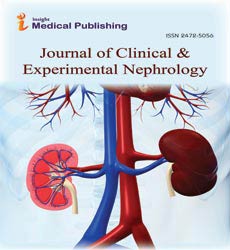Trends and Impact of Gender on Renal Transplantation
Jafree Long*
Department of Physiology, Anatomy and Genetics, University of Oxford, United Kingdom
- *Corresponding Author:
- Jafree Long
Department of Physiology, Anatomy and Genetics, University of Oxford,
United Kingdom;
E-mail: J.long@ucl.ac.uk
Received: February 18, 2022, Manuscript No. IPJCEN-22-11495; Editor assigned: February 21, 2022, PreQC No. IPJCEN-22-11495 (PQ); Reviewed: March 07, 2022, QC No. IPJCEN-22-11495; Revised: March 11, 2022, Manuscript No. IPJCEN-22-11495 (R); Published: March 18, 2022, Invoice No. IPJCEN-22-11495
Citation: Long J (2022) Trends and Impact of Gender on Renal Transplantation. J Clin Exp Nephrol Vol:7 No:1
Editorial
The North American Pediatric Renal Transplant Cooperative Study has gathered clinical data on kids going through a renal transplantation starting around 1987. This helpful gathering currently remembers more than 150 taking interest clinical habitats for the United States, Canada, Mexico, and Costa Rica. This report covers the years from 1987 through 2001 and remembers information for 7545 renal transfers in 6878 patients. This report exhibits changing patterns in numerous spaces of pediatric transplantation including expanding quantities of African American and Hispanic youngsters getting transplantation, noteworthy enhancements in the pace of intense dismissal, dismissal inversion, and short-and long haul allograft endurance. In the latest accomplices of patients, we presently see that 1 yr allograft endurance is the same in dead body contributor contrasted with living giver beneficiaries and in babies contrasted with any remaining age gatherings. In any case, this examination likewise uncovers spaces of preceded with difficulties remembering substandard results for African American and juvenile populaces, ongoing dismissal, and the antagonistic impacts of immune suppression.
The normal reason for immunosuppressive treatments in renal transplantation is to utilize various specialists to chip away at various immunologic targets. The utilization of a multidrug routine takes into account pharmacologic action at a few vital stages in the T-cell replication cycle and lower doses of every individual specialist, subsequently delivering less medication related poison levels. As a general rule, there are three phases of clinical immunosuppression: enlistment treatment, upkeep treatment, and treatment of a set up intense dismissal scene. Just immunosuppressive treatments utilized for support treatment are talked about exhaustively in this audit. The most widely recognized upkeep immunosuppressive specialists can be isolated into five classes: (1) The Calcineurin Inhibitors (CNIs) (cyclosporine and tacrolimus), (2) costimulation blockers (belatacept), (3) mammalian objective of rapamycin inhibitors (sirolimus and everolimus), (4) antiproliferatives (azathioprine and mycophenolic corrosive subordinates), and (5) corticosteroids. Immunosuppressive regimens fluctuate among transplantation focuses however frequently incorporate a CNI and an adjuvant specialist, with or without corticosteroids. Choice of fitting immunosuppressive regimens ought to show restraint explicit, considering the meds' pharmacologic properties, antagonistic occasion profile, and potential medication drug collaborations, just as the patient's previous infections, hazard of dismissal, and medicine routine.
Progressions in relocate immunosuppression have brought about a huge decrease in intense cell dismissal and an unobtrusive expansion in long haul patient and join endurance. Since the ideal immunosuppression routine is as yet unclear, immunosuppressant use ought to be affected by institutional inclination and custom-made to the immunologic danger of the patient and unfriendly impact profile of the medication.
Both transfer and dialysis results have worked on over late years. Furthermore, transplantation has been displayed to present an endurance advantage over upkeep dialysis. The review introduced here resolves whether or not the endurance advantage of transplantation over support dialysis has changed in the latest periods. This review depended on information gathered by the United States Renal Transplant Scientific Registry and the United States Renal Data System. The review test comprised of 104,000 patients put on the renal transfer holding up list somewhere in the range of 1988 and 1996, of which 73,707 thusly got renal transfers. The annualized changed death rates per 1000 patient-years were determined by schedule year of situation on the renal transfer hanging tight rundown and for kidney relocate beneficiaries. The subsequent information was plotted, and direct bend fitting was utilized to appraise the slant of the difference in the changed death rates by year during the period considered, 1988 to 1996. Generally speaking yearly changed passing rates in the stand by recorded patients and relocate beneficiaries per 1000 patient-years diminished for the two gatherings all through the review time frame. From 1989 to 1996, the relative danger (RR) for patient passing had diminished by 30% for relocate beneficiaries and 23% for stand by recorded patients (RR=0.70 and 0.77; P<0.0001 each). Slant investigation of the reason explicit death rates for cardiovascular illness and contamination showed almost same, direct declines for the two gatherings. Death rates have worked on generally and by classifications of significant reason for death for both renal transfer beneficiaries and patients on the renal transfer holding up list. These ideal patterns no doubt address equivalent advances in transplantation, dialysis, and general clinical consideration.
Open Access Journals
- Aquaculture & Veterinary Science
- Chemistry & Chemical Sciences
- Clinical Sciences
- Engineering
- General Science
- Genetics & Molecular Biology
- Health Care & Nursing
- Immunology & Microbiology
- Materials Science
- Mathematics & Physics
- Medical Sciences
- Neurology & Psychiatry
- Oncology & Cancer Science
- Pharmaceutical Sciences
